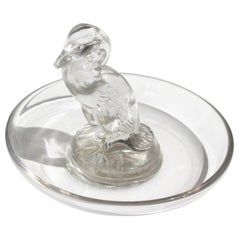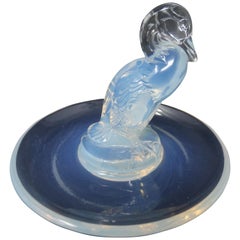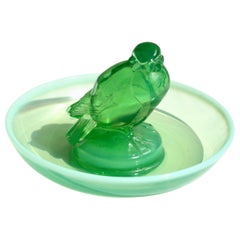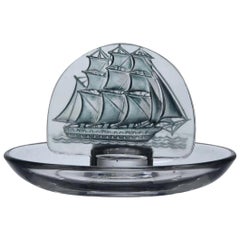Lalique Cendrier
René Lalique "Canard" Cendrier, Marcilhac No. 283
By René Lalique
Located in West Palm Beach, FL
René Lalique (1860-1945)
"Canard" Cendrier,
Marcilhac NO. 283
Script signature R. LALIQUE
Category
Vintage 1920s Vases
Materials
Art Glass
René Lalique '1860-1945' Opalescent Glass Cendrier
By René Lalique
Located in West Palm Beach, FL
René Lalique (1860-1945)
An opalescent glass cendrier, Marcilhac No. 290, acid stamped R. Lalique
Category
20th Century Animal Sculptures
Materials
Glass
René Lalique '1860-1945' "Souris" Cendrier, Marcilhac No. 286
By René Lalique
Located in West Palm Beach, FL
René Lalique(1860-1945)
"Souris" Cendrier,
Marcilhac NO. 286
script signature R. LALIQUE
Category
20th Century Vases
Materials
Glass
René Lalique Opalescent Glass 'Canard Duck' Cendrier Rond/Ashtray
By René Lalique
Located in Chelmsford, Essex
René Lalique opalescent glass 'Canard (duck)' Cendrier rond/ashtray. Engraved makers mark, 'R
Category
Vintage 1920s French Art Deco Barware
Materials
Glass
René Lalique '1860-1945' "Moineau" Cendrier Marcilhac NO. 284
By René Lalique
Located in West Palm Beach, FL
René Lalique (1860-1945)
"Moineau" Cendrier
Marcilhac NO. 284
Script signature R. LALIQUE
Category
20th Century Animal Sculptures
Materials
Glass
Recent Sales
Pair of Brand New in the Box Rene Lalique Cendrier Honfleur Small Dishes Bowls
By Lalique
Located in GB
original box and packaging Lalique Cendrier Honfleur small bowls
A good looking well made and decorative
Category
20th Century French Art Nouveau Vanity Items
H 1.5 in W 5.91 in D 5.91 in
French Art Deco Clear Glass Vase "Caravelle" Pintray by René Lalique
By René Lalique
Located in London, GB
Caravel sailing ship at full sail, signed R Lalique
Cendrier Rond "Caravelle"
Catalogue number: 312
Category
Vintage 1930s French Art Deco Vases
Materials
Glass
Lalique Ecureuil Cendrier
By René Lalique
Located in Forest Row, East Sussex
set over a moulded pressed, opalescent glass squirrel. Model no. 315. Literature: Marcilhac, R Lalique
Category
Vintage 1930s French Art Deco More Desk Accessories
Materials
Glass
Lalique Moineau Cendrier
By René Lalique
Located in Forest Row, East Sussex
, opalescent glass sparrow. Model no. 284. Literature: Marcilhac, R Lalique Catalogue Raisonné de L’Œuvre de
Category
Vintage 1920s French Art Deco More Desk Accessories
Materials
Glass
René Lalique Opalescent Glass 'Deux Colombes' Cendrier Ashtray
By René Lalique
Located in Chelmsford, Essex
Renè Lalique opalescent glass 'Deux Colombes' Cendrier ashtray. Stencilled makers mark, 'R. Lalique
Category
Vintage 1930s French Art Deco Barware
Materials
Glass
R. Lalique Clear & Frosted Crystal JAMAIQUE Ashtray, c. 1928
By René Lalique
Located in Ciudad Autónoma Buenos Aires, AR
BEAUTIFUL ORIGINAL SIGNED R. LALIQUE CLEAR AND FROSTED CENDRIER/ASHTRAY IN THE "JAMAIQUE" PATTERN
Category
Vintage 1920s French Art Nouveau Ashtrays
Materials
Art Glass
René Lalique Cendrier "Archers" Ashtray
By René Lalique
Located in Saint-Ouen, FR
Rene Lalique Cendrier Archers: 11.5 cm wide clear glass with a frosted and grey blue patinated men
Category
Vintage 1920s French Art Deco More Desk Accessories
Materials
Art Glass
Lalique Cendrier "Jamaïque"
By Lalique
Located in Saint-Ouen, FR
clear glass center 2,9 X 14 cm
signed Lalique france
Bibliography : Félix Marcilhac, catalogue
Category
Vintage 1950s European Art Deco Ashtrays
Materials
Art Glass
Lalique Bowl "Nancy Cendrier"
By Lalique
Located in Stamford, CT
Lalique vintage bowl clear to frosted scalloped edge, circa 1980s. Spiral design in center. Signed
Category
Vintage 1980s French Glass
Materials
Glass
Lalique France Cendrier ou Baguier
By Lalique
Located in Saint-Ouen, FR
Clear glass small dish form with a bird figure rising from the center of the Lalique ashtray
Category
Vintage 1950s French Art Deco Decorative Dishes and Vide-Poche
Materials
Art Glass
René Lalique Ashtray "Champagne Mumm"
By René Lalique
Located in Saint-Ouen, FR
hair and the wording "Ste Vle de Champagne G.H. Mumm & Cie" R. Lalique Ashtray.
Cendrier “Champagne
Category
Vintage 1930s French Art Deco Decorative Dishes and Vide-Poche
Materials
Art Glass
Rene Lalique Cendrier Fauvettes
Located in Saint-Ouen, FR
Rene Lalique Cendrier Fauvettes: Clear & grey patina glass with an 8 pointed frosted warblers
Category
Vintage 1920s Ashtrays
Materials
Blown Glass
Lalique France Cendrier ou Baguier
By Lalique
Located in Saint-Ouen, FR
Clear glass small dish form with a antilope figure rising from the center of the Lalique ashtray
Category
Vintage 1950s French Art Deco Decorative Dishes and Vide-Poche
Materials
Art Glass
Lalique Gao Cendrier or Ashtray or Decrotive Bowl, Hand Signed Lalique
By Lalique
Located in St. Petersburg, FL
Lalique Gao Cendrier (ashtray) Bowl. Satin serpentine border with clear round marbles. Marked
Category
Mid-20th Century French Decorative Bowls
Materials
Crystal
People Also Browsed
Rene Lalique Clear Glass Danaides Vase
By René Lalique
Located in Chelmsford, Essex
Rene Lalique Clear and Frosted Glass 'Danaides' Vase. This pattern features the Daughters of Danaus stood pouring water from a vessel. Molded makers mark, 'R. LALIQUE', to the unders...
Category
Vintage 1920s French Art Deco Vases
Materials
Glass
A René LALIQUE Opalescent Glass Bacchantes Vase
By René Lalique
Located in SAINT-OUEN-SUR-SEINE, FR
The Bacchantes vase was made in 1927 by R.Lalique in white glass.
The opalescent version is probably one of R.Lalique's most famous and published vases .
This example is in perfect...
Category
Vintage 1920s French Art Deco Vases
Materials
Glass
"Ceylan" Vase by René Lalique
By René Lalique
Located in Ciudad Autónoma Buenos Aires, C
"Ceylan" vase by René Lalique.
Félix Marcilhac (1989) "R. Lalique: Catalogue Raisonné De L'oeuvre De Verre" p. 418.
France, CIRCA 1920.
Category
Vintage 1920s French Art Deco Vases
Materials
Glass
René Lalique 'Bouchardon' Signature R. Lalique Marcilhac 981
By René Lalique
Located in West Palm Beach, FL
René Lalique, (1860-1945)
'BOUCHARDON'
A clear and frosted glass vase with a bluish green patina,
Model introduced, 1926
Marcilhac 981,
Size: 4 1/4 in. (10.8 cm) high
Script si...
Category
Vintage 1920s Vases
Materials
Glass
Rene Lalique Original Art Deco Opalescent Vitesse Car Mascot
By René Lalique
Located in Northampton, GB
Original Car Mascot #1160
From our Rene Lalique collection, we are delighted to offer this stunning Rene Lalique Opalescent Vitesse car mascot also known as the “Goddess of Speed“. ...
Category
Early 20th Century French Art Deco Glass
Materials
Glass
René Lalique, "MARISA" Glass Vase, Marcilhac No. 1002
By René Lalique
Located in West Palm Beach, FL
René Lalique (1860-1945)
"MARISA" glass vase, Marcilhac No. 1002
signed R. LALIQUE, France
clear and frosted glass
Height 4.87 in, diameter 9.25 in.
Height 12.36 cm., diameter 2...
Category
Antique Late 19th Century Vases
Materials
Art Glass
René Lalique Domremy Glass Vase, Marcilhac No. 979, Signed R. Lalique
By René Lalique
Located in West Palm Beach, FL
René Lalique (1860-1945)
"Domremy" glass vase, Marcilhac no. 979
molded signature R. Lalique
opalescent glass
Height 8.37 in, diameter 7.50 in.
Height 21.25 cm., diameter 19.05 ...
Category
Mid-20th Century Vases
Materials
Glass
$5,200 Sale Price
20% Off
H 8.37 in Dm 7.5 in
René Lalique, "Poissons", Marcilhac No.925, circa 1921
By René Lalique
Located in West Palm Beach, FL
René Lalique (1860-1945)
"Poissons", Marcilhac No.925
circa 1921
engraved R. LALIQUE
Opalescent glass with a silver top rim (hallmarked).
Measures: height 9.50 in., diameter 10...
Category
Vintage 1920s Vases
Materials
Glass
Get Updated with New Arrivals
Save "Lalique Cendrier", and we’ll notify you when there are new listings in this category.
Lalique Cendrier For Sale on 1stDibs
Find many varieties of an authentic lalique cendrier available at 1stDibs. Frequently made of glass, art glass and blown glass, every lalique cendrier was constructed with great care. There are many kinds of the lalique cendrier you’re looking for, from those produced as long ago as the 20th Century to those made as recently as the 20th Century. When you’re browsing for the right lalique cendrier, those designed in Art Deco styles are of considerable interest. Many designers have produced at least one well-made lalique cendrier over the years, but those crafted by René Lalique and Lalique are often thought to be among the most beautiful.
How Much is a Lalique Cendrier?
Prices for a lalique cendrier start at $135 and top out at $2,950 with the average selling for $985.






